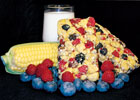
Nutritionally enhanced foods, particularly beverages and bars, are on a fast track. The market for nutrition/energy bars is red-hot, with sales growth of 169% from 1999 to 2004, according to Mintel. Similarly, in the beverage arena, Beverage Marketing Corporation Inc. (BMC), New York, projects 4.8% growth from 2005 to 2009 in health beverages, a large category that also includes milk, juice and water.
Where do many of these products get their advantage? In short, the answer is whey protein. Whey protein is a high-quality protein that provides all of the essential amino acids necessary for good health, making it an ideal ingredient. What is exciting is that manufacturers of bars and beverages now have sound science to back up a whey protein structure-function claim related to muscle mass.
At the 2006 DMI Dairy Innovation Forum, Tia Rains, PhD, DMI nutrition consultant and adjunct faculty member, Rosalind Franklin University (West Chicago, Ill.), discussed the benefits of whey on muscle that may be communicated to consumers as a potential structure-function claim. Based on the totality of scientific studies in which people consumed whey protein, there is solid science behind her claim that whey protein helps maintain and build new muscle mass. Clinical studies have shown that whey protein independently stimulates muscle protein synthesis, stimulates protein synthesis better than carbohydrates alone and augments new muscle protein after resistance exercise.
While the nutrition news is exciting for whey, that is just one of the reasons manufacturers turn to whey ingredients. The clean, neutral taste and multifaceted functional benefits of whey protein add to its appeal.

Whey in Beverages
Product developers are seeking out whey's taste attributes and functionality to tap the tremendous growth opportunities in the beverage category. Also at the 2006 DMI Dairy Innovation Forum, Julia Kadison, managing director and chief operating officer of BMC, stated that the best opportunity for dairy ingredients such as whey protein is where health, wellness and functional beverages overlap. This is specifically true in isotonics, nutrient-enhanced beverages, meal replacements, ready-to-drink sports nutrition drinks, and dairy-based beverages like yogurt drinks/smoothies, milk drinks and ready-to-drink coffees. BMC projects a 10% increase through 2009 in this non-traditional area for dairy.“Dairy ingredients' best play is in the emerging high-growth functional/wellness overlap,” said Kadison. In the ready-to-drink sports nutrition area alone, where a label claim about muscle building and maintenance could help drive sales, the projected growth is 16%.
In terms of functionality, whey protein isolate and whey protein concentrate increase and enhance protein content while also improving beverage quality. Whey proteins work in a variety of beverages due to their solubility over a wide pH range. They need protection from heat in the pH range of 3.5-7, but through the assistance of stabilizers in the 3.5-4.5 range, and stabilizers and buffers in the neutral range, they will maintain their solubility. In addition, beverages high in acid (with a pH range of 2.8-3.5), such as soda and energy drinks, exhibit excellent clarity when whey protein isolate is used. The clarity increases as pH decreases.
Whey proteins emulsify fat-containing beverages and aerate shake-type drinks, resulting in good stability and mouthfeel. Its gelling properties add opacity to high-protein beverages. Modified whey proteins also function as thickeners in lower-carb beverages, replacing starches or other carbohydrates. Some whey ingredients are available instantized, for use in the formulation of instant drink mixes. Whey protein traditionally imparts a flavor that makes it ideal for citrus and fruit-flavored drinks, as well as traditional milk, vanilla and chocolate beverages.

Whey in Nutrition Bars
Nutrition bars, ranging from sports and energy bars to cereal, weight management and meal replacement bars, all can benefit from whey's nutritional benefits. A long-time favorite of athletes, whey proteins are being used at higher levels to boost the protein in nutrition bars, where they offer one of the best sources of essential amino acids and the highest level of branched chain amino acids (BCAA) of any protein ingredient source.Whey manufacturers have developed a variety of new ingredients to help prevent hardening in high-protein nutrition bars. Most involve a combination of whey protein concentrate or isolate and hydrolyzed whey proteins. Hydrolyzed whey proteins have been enzymatically modified to break the large protein molecules into smaller whey peptides that do not draw moisture away from other ingredients, helping to maintain product shelflife. Several new whey ingredients have emerged with a combination of regular and hydrolyzed whey proteins. These proprietary ingredients are the ideal solutions to maximizing protein in bars, while maintaining a consistent texture for up to one year.
Another benefit to bars is whey ingredients' great taste. Formulations do not require flavor masking, and the clean neutral flavor also enables other flavors to develop to their full potential. In addition, because whey is multifunctional, it can reduce the need for other emulsifiers, stabilizers or structure-forming ingredients and could result in significant cost savings.
Laura Gottschalk is director, U.S. Manufacturing and Ingredient Marketing, for Dairy Management Inc. DMI provides funding and technical expertise for research in the dairy industry.